(pdf) Paramedical sciences and services
VerifiedAdded on 2021/05/30
|12
|3441
|31
AI Summary
Contribute Materials
Your contribution can guide someone’s learning journey. Share your
documents today.
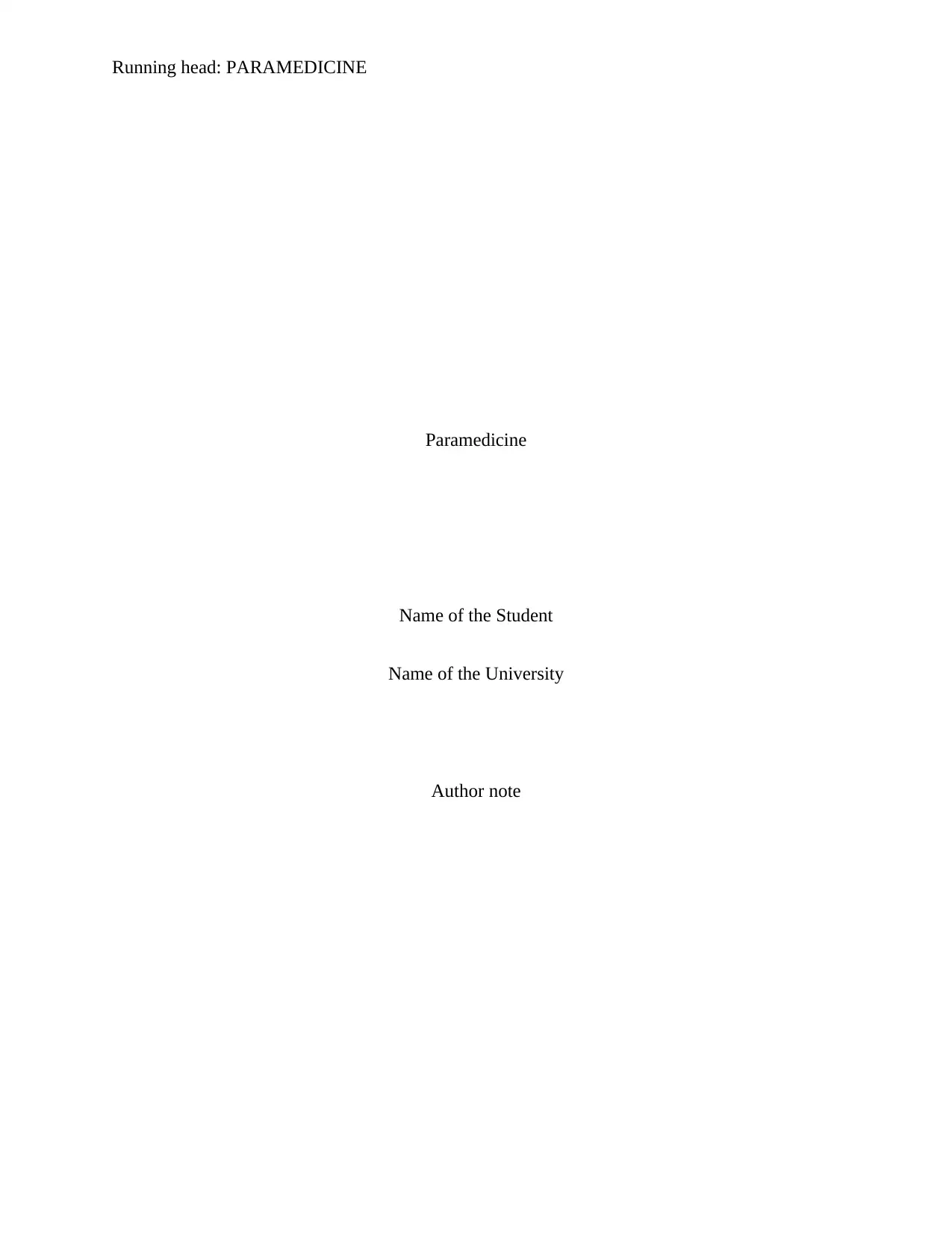
Running head: PARAMEDICINE
Paramedicine
Name of the Student
Name of the University
Author note
Paramedicine
Name of the Student
Name of the University
Author note
Secure Best Marks with AI Grader
Need help grading? Try our AI Grader for instant feedback on your assignments.

2PARAMEDICINE
Introduction
The essay discusses the hospital management of the patient named Amit Singh, 58 year
old presented with the chest pain and vomiting. In response to the case study the essay discusses
the pathophysiology of the presenting condition of the patient along with brief highlight on the
epidemiology and the risk factors. The essay further presents the hospital management of the
patient’s condition. The essay discusses in details about the general management of the condition
as well as the national and international guidelines used in this process. The evidence is
supported with literature and the factors such as hospital, geographical, or regional factors that
may affect the patient management are also discussed.
Patient presenting condition
In the given case study the patient was NBN installer and was travelling for work. While
working in the remote area the person had onset of nausea and vomiting with pain in his chest,
left arm and jaw thirty minutes ago. It was described by the bystander that the Mr Singh quickly
becoming pale and sweaty before vomiting. The past medical history of the patient reveals of the
Hypertension, hypercholesterolaemia and type two diabetes mellitus. There is the family history
of heart attack (in case of father) and stents (in case of brother). The patient’s social history
reveals him to have a sedentary lifestyle with poor diet pattern. The patient consumes fat rich
food and high sugar containing diet. It is because the patient is traveler and mostly eats outside
home. On examination it was fund that the patient had central chest pain that is described by the
patient as heavy like sitting on chest and rated severity is 7/10. The patient feels tightening
numbness in left arm and jaw. The pain is persistent and non changing with the associated
symtoms like Nausea, vomiting, pallor and diaphoresis. On observation the patient showed up
Introduction
The essay discusses the hospital management of the patient named Amit Singh, 58 year
old presented with the chest pain and vomiting. In response to the case study the essay discusses
the pathophysiology of the presenting condition of the patient along with brief highlight on the
epidemiology and the risk factors. The essay further presents the hospital management of the
patient’s condition. The essay discusses in details about the general management of the condition
as well as the national and international guidelines used in this process. The evidence is
supported with literature and the factors such as hospital, geographical, or regional factors that
may affect the patient management are also discussed.
Patient presenting condition
In the given case study the patient was NBN installer and was travelling for work. While
working in the remote area the person had onset of nausea and vomiting with pain in his chest,
left arm and jaw thirty minutes ago. It was described by the bystander that the Mr Singh quickly
becoming pale and sweaty before vomiting. The past medical history of the patient reveals of the
Hypertension, hypercholesterolaemia and type two diabetes mellitus. There is the family history
of heart attack (in case of father) and stents (in case of brother). The patient’s social history
reveals him to have a sedentary lifestyle with poor diet pattern. The patient consumes fat rich
food and high sugar containing diet. It is because the patient is traveler and mostly eats outside
home. On examination it was fund that the patient had central chest pain that is described by the
patient as heavy like sitting on chest and rated severity is 7/10. The patient feels tightening
numbness in left arm and jaw. The pain is persistent and non changing with the associated
symtoms like Nausea, vomiting, pallor and diaphoresis. On observation the patient showed up
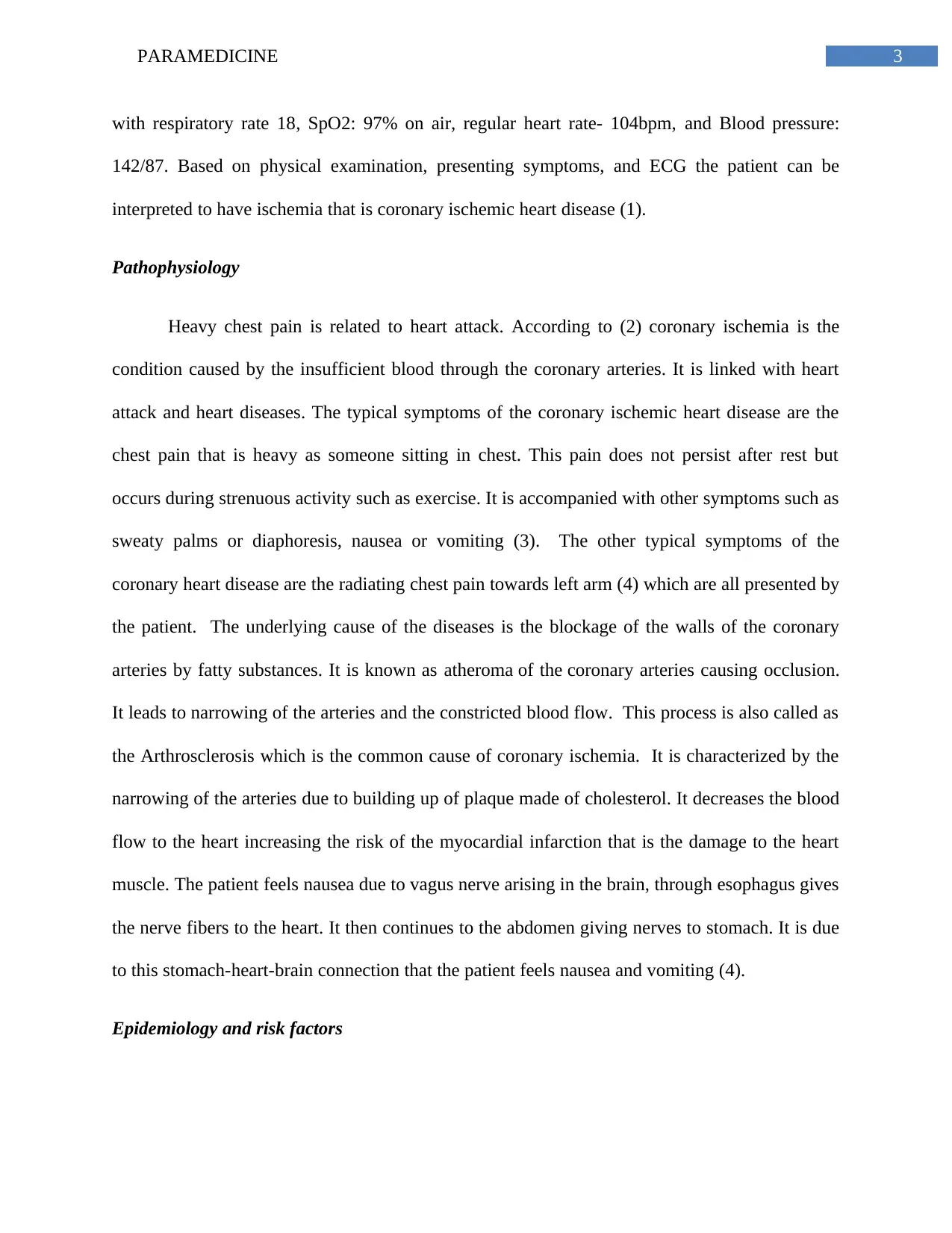
3PARAMEDICINE
with respiratory rate 18, SpO2: 97% on air, regular heart rate- 104bpm, and Blood pressure:
142/87. Based on physical examination, presenting symptoms, and ECG the patient can be
interpreted to have ischemia that is coronary ischemic heart disease (1).
Pathophysiology
Heavy chest pain is related to heart attack. According to (2) coronary ischemia is the
condition caused by the insufficient blood through the coronary arteries. It is linked with heart
attack and heart diseases. The typical symptoms of the coronary ischemic heart disease are the
chest pain that is heavy as someone sitting in chest. This pain does not persist after rest but
occurs during strenuous activity such as exercise. It is accompanied with other symptoms such as
sweaty palms or diaphoresis, nausea or vomiting (3). The other typical symptoms of the
coronary heart disease are the radiating chest pain towards left arm (4) which are all presented by
the patient. The underlying cause of the diseases is the blockage of the walls of the coronary
arteries by fatty substances. It is known as atheroma of the coronary arteries causing occlusion.
It leads to narrowing of the arteries and the constricted blood flow. This process is also called as
the Arthrosclerosis which is the common cause of coronary ischemia. It is characterized by the
narrowing of the arteries due to building up of plaque made of cholesterol. It decreases the blood
flow to the heart increasing the risk of the myocardial infarction that is the damage to the heart
muscle. The patient feels nausea due to vagus nerve arising in the brain, through esophagus gives
the nerve fibers to the heart. It then continues to the abdomen giving nerves to stomach. It is due
to this stomach-heart-brain connection that the patient feels nausea and vomiting (4).
Epidemiology and risk factors
with respiratory rate 18, SpO2: 97% on air, regular heart rate- 104bpm, and Blood pressure:
142/87. Based on physical examination, presenting symptoms, and ECG the patient can be
interpreted to have ischemia that is coronary ischemic heart disease (1).
Pathophysiology
Heavy chest pain is related to heart attack. According to (2) coronary ischemia is the
condition caused by the insufficient blood through the coronary arteries. It is linked with heart
attack and heart diseases. The typical symptoms of the coronary ischemic heart disease are the
chest pain that is heavy as someone sitting in chest. This pain does not persist after rest but
occurs during strenuous activity such as exercise. It is accompanied with other symptoms such as
sweaty palms or diaphoresis, nausea or vomiting (3). The other typical symptoms of the
coronary heart disease are the radiating chest pain towards left arm (4) which are all presented by
the patient. The underlying cause of the diseases is the blockage of the walls of the coronary
arteries by fatty substances. It is known as atheroma of the coronary arteries causing occlusion.
It leads to narrowing of the arteries and the constricted blood flow. This process is also called as
the Arthrosclerosis which is the common cause of coronary ischemia. It is characterized by the
narrowing of the arteries due to building up of plaque made of cholesterol. It decreases the blood
flow to the heart increasing the risk of the myocardial infarction that is the damage to the heart
muscle. The patient feels nausea due to vagus nerve arising in the brain, through esophagus gives
the nerve fibers to the heart. It then continues to the abdomen giving nerves to stomach. It is due
to this stomach-heart-brain connection that the patient feels nausea and vomiting (4).
Epidemiology and risk factors
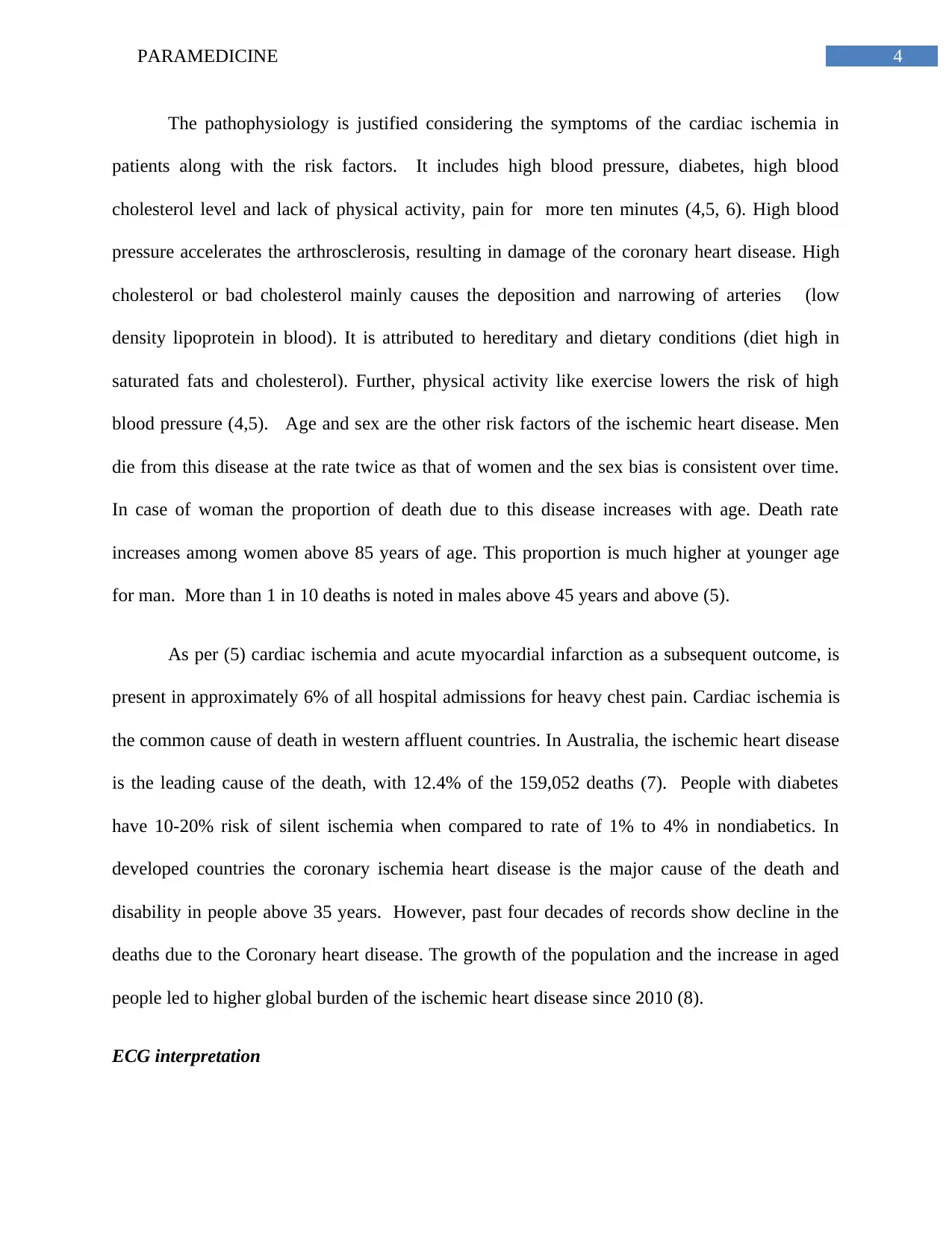
4PARAMEDICINE
The pathophysiology is justified considering the symptoms of the cardiac ischemia in
patients along with the risk factors. It includes high blood pressure, diabetes, high blood
cholesterol level and lack of physical activity, pain for more ten minutes (4,5, 6). High blood
pressure accelerates the arthrosclerosis, resulting in damage of the coronary heart disease. High
cholesterol or bad cholesterol mainly causes the deposition and narrowing of arteries (low
density lipoprotein in blood). It is attributed to hereditary and dietary conditions (diet high in
saturated fats and cholesterol). Further, physical activity like exercise lowers the risk of high
blood pressure (4,5). Age and sex are the other risk factors of the ischemic heart disease. Men
die from this disease at the rate twice as that of women and the sex bias is consistent over time.
In case of woman the proportion of death due to this disease increases with age. Death rate
increases among women above 85 years of age. This proportion is much higher at younger age
for man. More than 1 in 10 deaths is noted in males above 45 years and above (5).
As per (5) cardiac ischemia and acute myocardial infarction as a subsequent outcome, is
present in approximately 6% of all hospital admissions for heavy chest pain. Cardiac ischemia is
the common cause of death in western affluent countries. In Australia, the ischemic heart disease
is the leading cause of the death, with 12.4% of the 159,052 deaths (7). People with diabetes
have 10-20% risk of silent ischemia when compared to rate of 1% to 4% in nondiabetics. In
developed countries the coronary ischemia heart disease is the major cause of the death and
disability in people above 35 years. However, past four decades of records show decline in the
deaths due to the Coronary heart disease. The growth of the population and the increase in aged
people led to higher global burden of the ischemic heart disease since 2010 (8).
ECG interpretation
The pathophysiology is justified considering the symptoms of the cardiac ischemia in
patients along with the risk factors. It includes high blood pressure, diabetes, high blood
cholesterol level and lack of physical activity, pain for more ten minutes (4,5, 6). High blood
pressure accelerates the arthrosclerosis, resulting in damage of the coronary heart disease. High
cholesterol or bad cholesterol mainly causes the deposition and narrowing of arteries (low
density lipoprotein in blood). It is attributed to hereditary and dietary conditions (diet high in
saturated fats and cholesterol). Further, physical activity like exercise lowers the risk of high
blood pressure (4,5). Age and sex are the other risk factors of the ischemic heart disease. Men
die from this disease at the rate twice as that of women and the sex bias is consistent over time.
In case of woman the proportion of death due to this disease increases with age. Death rate
increases among women above 85 years of age. This proportion is much higher at younger age
for man. More than 1 in 10 deaths is noted in males above 45 years and above (5).
As per (5) cardiac ischemia and acute myocardial infarction as a subsequent outcome, is
present in approximately 6% of all hospital admissions for heavy chest pain. Cardiac ischemia is
the common cause of death in western affluent countries. In Australia, the ischemic heart disease
is the leading cause of the death, with 12.4% of the 159,052 deaths (7). People with diabetes
have 10-20% risk of silent ischemia when compared to rate of 1% to 4% in nondiabetics. In
developed countries the coronary ischemia heart disease is the major cause of the death and
disability in people above 35 years. However, past four decades of records show decline in the
deaths due to the Coronary heart disease. The growth of the population and the increase in aged
people led to higher global burden of the ischemic heart disease since 2010 (8).
ECG interpretation
Secure Best Marks with AI Grader
Need help grading? Try our AI Grader for instant feedback on your assignments.

5PARAMEDICINE
In order to manage the patient care it is necessary to interpret the ECG that determines
the risks and care needed by the patient. Optimal use of the ECG helps in diagnosis, prognosis
and appropriate treatment. In the given case study the use of ECG is important to get the
information on the localisation and time course of ischemia (1). In the normal heart the regular
sinus rhythm 82 beats per minute. The P wave is observed to be upright in leads I, aVF and V3 -
V6 and the polarity is positive in the leads I, II, aVF and V4 - V6. The PR interval is between the
0.12 and 0.20 seconds. The QRS complex shows a small Q wave in I, aVL, V5 and V6 that may
have same amplitude as the R wave. A large upright R is detected with the large deep S and
when proceeding with the V1 to V6, S waves get small and R get taller. These waves are equal at
the transitional zone. In the normal ECG ST Segment is slanting upwards to the T wave. This
segment marks the ventricular depolarisation and repolarisation. In the T wave the deflection
would be same as that of the QRS complex in atleast 5-6 leads (9). On the contrary to this, the
ECG of Amit Singh is quite different. In QRS complex, there is no positive deflection seen with
large upright R in V4 - V6 there is no negative deflection with large deep S in the V1 and V2. ST
elevation was observed in 3-4 chest leads which is the block pattern that is ST-T changes (1,10).
According to (10) ischemia is characterised by the ST elevation. In the patient’s ECG T wave
can be called as T wave inversion (negative wave). With increasing amplitude there is flattening
of T waves. The ST changes are strong indication for chest discomfort. It is also the risk factor
for subsequent myocardial infarction.
Emergency care
This is an emergency situation as the ECG reveals the possibility of the heart attack in
the patient and it would take long time before the patient is taken to the hospital with good
cardiac facility. The patient is at risk of death as the preliminary diagnosis. The patient may be
In order to manage the patient care it is necessary to interpret the ECG that determines
the risks and care needed by the patient. Optimal use of the ECG helps in diagnosis, prognosis
and appropriate treatment. In the given case study the use of ECG is important to get the
information on the localisation and time course of ischemia (1). In the normal heart the regular
sinus rhythm 82 beats per minute. The P wave is observed to be upright in leads I, aVF and V3 -
V6 and the polarity is positive in the leads I, II, aVF and V4 - V6. The PR interval is between the
0.12 and 0.20 seconds. The QRS complex shows a small Q wave in I, aVL, V5 and V6 that may
have same amplitude as the R wave. A large upright R is detected with the large deep S and
when proceeding with the V1 to V6, S waves get small and R get taller. These waves are equal at
the transitional zone. In the normal ECG ST Segment is slanting upwards to the T wave. This
segment marks the ventricular depolarisation and repolarisation. In the T wave the deflection
would be same as that of the QRS complex in atleast 5-6 leads (9). On the contrary to this, the
ECG of Amit Singh is quite different. In QRS complex, there is no positive deflection seen with
large upright R in V4 - V6 there is no negative deflection with large deep S in the V1 and V2. ST
elevation was observed in 3-4 chest leads which is the block pattern that is ST-T changes (1,10).
According to (10) ischemia is characterised by the ST elevation. In the patient’s ECG T wave
can be called as T wave inversion (negative wave). With increasing amplitude there is flattening
of T waves. The ST changes are strong indication for chest discomfort. It is also the risk factor
for subsequent myocardial infarction.
Emergency care
This is an emergency situation as the ECG reveals the possibility of the heart attack in
the patient and it would take long time before the patient is taken to the hospital with good
cardiac facility. The patient is at risk of death as the preliminary diagnosis. The patient may be
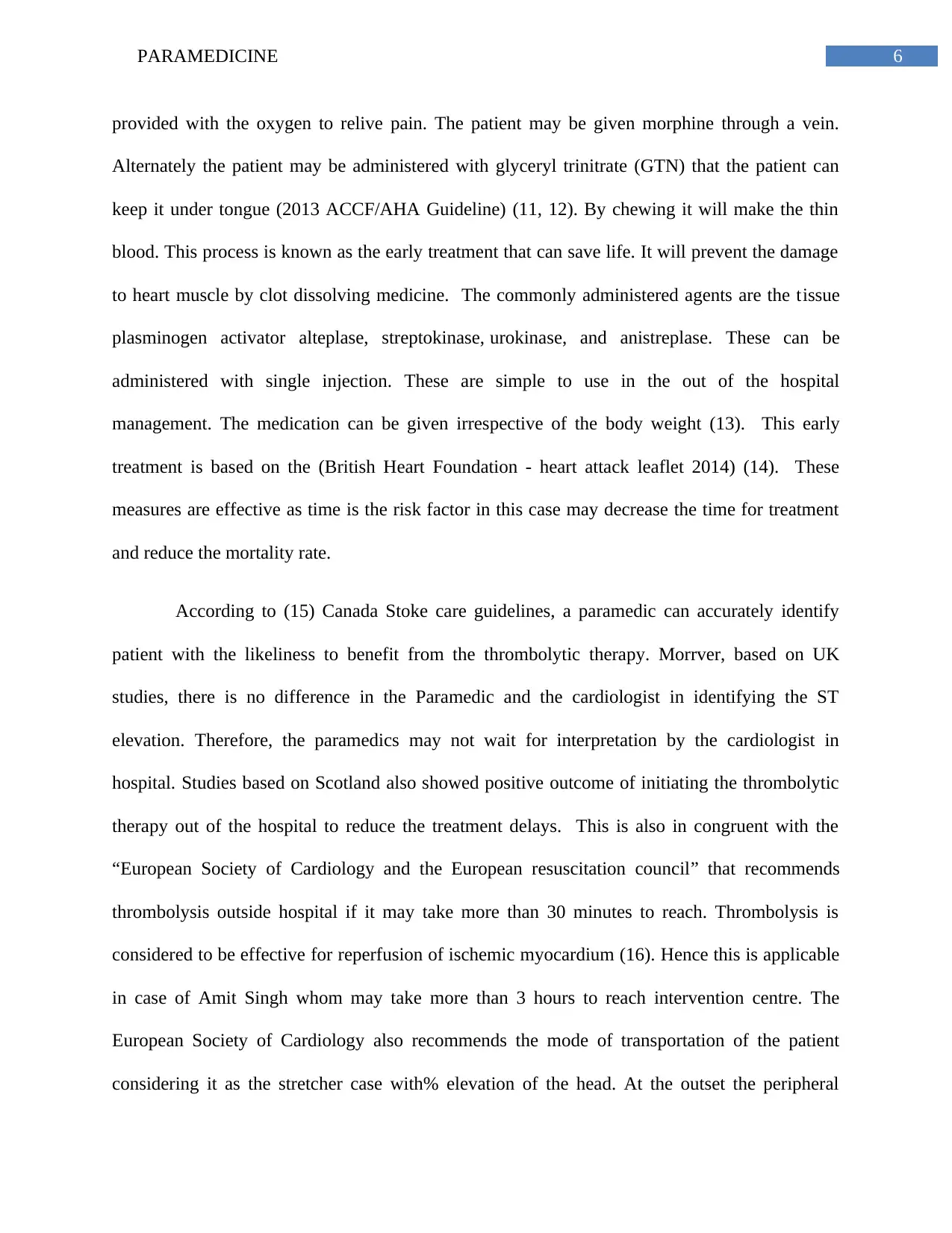
6PARAMEDICINE
provided with the oxygen to relive pain. The patient may be given morphine through a vein.
Alternately the patient may be administered with glyceryl trinitrate (GTN) that the patient can
keep it under tongue (2013 ACCF/AHA Guideline) (11, 12). By chewing it will make the thin
blood. This process is known as the early treatment that can save life. It will prevent the damage
to heart muscle by clot dissolving medicine. The commonly administered agents are the tissue
plasminogen activator alteplase, streptokinase, urokinase, and anistreplase. These can be
administered with single injection. These are simple to use in the out of the hospital
management. The medication can be given irrespective of the body weight (13). This early
treatment is based on the (British Heart Foundation - heart attack leaflet 2014) (14). These
measures are effective as time is the risk factor in this case may decrease the time for treatment
and reduce the mortality rate.
According to (15) Canada Stoke care guidelines, a paramedic can accurately identify
patient with the likeliness to benefit from the thrombolytic therapy. Morrver, based on UK
studies, there is no difference in the Paramedic and the cardiologist in identifying the ST
elevation. Therefore, the paramedics may not wait for interpretation by the cardiologist in
hospital. Studies based on Scotland also showed positive outcome of initiating the thrombolytic
therapy out of the hospital to reduce the treatment delays. This is also in congruent with the
“European Society of Cardiology and the European resuscitation council” that recommends
thrombolysis outside hospital if it may take more than 30 minutes to reach. Thrombolysis is
considered to be effective for reperfusion of ischemic myocardium (16). Hence this is applicable
in case of Amit Singh whom may take more than 3 hours to reach intervention centre. The
European Society of Cardiology also recommends the mode of transportation of the patient
considering it as the stretcher case with% elevation of the head. At the outset the peripheral
provided with the oxygen to relive pain. The patient may be given morphine through a vein.
Alternately the patient may be administered with glyceryl trinitrate (GTN) that the patient can
keep it under tongue (2013 ACCF/AHA Guideline) (11, 12). By chewing it will make the thin
blood. This process is known as the early treatment that can save life. It will prevent the damage
to heart muscle by clot dissolving medicine. The commonly administered agents are the tissue
plasminogen activator alteplase, streptokinase, urokinase, and anistreplase. These can be
administered with single injection. These are simple to use in the out of the hospital
management. The medication can be given irrespective of the body weight (13). This early
treatment is based on the (British Heart Foundation - heart attack leaflet 2014) (14). These
measures are effective as time is the risk factor in this case may decrease the time for treatment
and reduce the mortality rate.
According to (15) Canada Stoke care guidelines, a paramedic can accurately identify
patient with the likeliness to benefit from the thrombolytic therapy. Morrver, based on UK
studies, there is no difference in the Paramedic and the cardiologist in identifying the ST
elevation. Therefore, the paramedics may not wait for interpretation by the cardiologist in
hospital. Studies based on Scotland also showed positive outcome of initiating the thrombolytic
therapy out of the hospital to reduce the treatment delays. This is also in congruent with the
“European Society of Cardiology and the European resuscitation council” that recommends
thrombolysis outside hospital if it may take more than 30 minutes to reach. Thrombolysis is
considered to be effective for reperfusion of ischemic myocardium (16). Hence this is applicable
in case of Amit Singh whom may take more than 3 hours to reach intervention centre. The
European Society of Cardiology also recommends the mode of transportation of the patient
considering it as the stretcher case with% elevation of the head. At the outset the peripheral
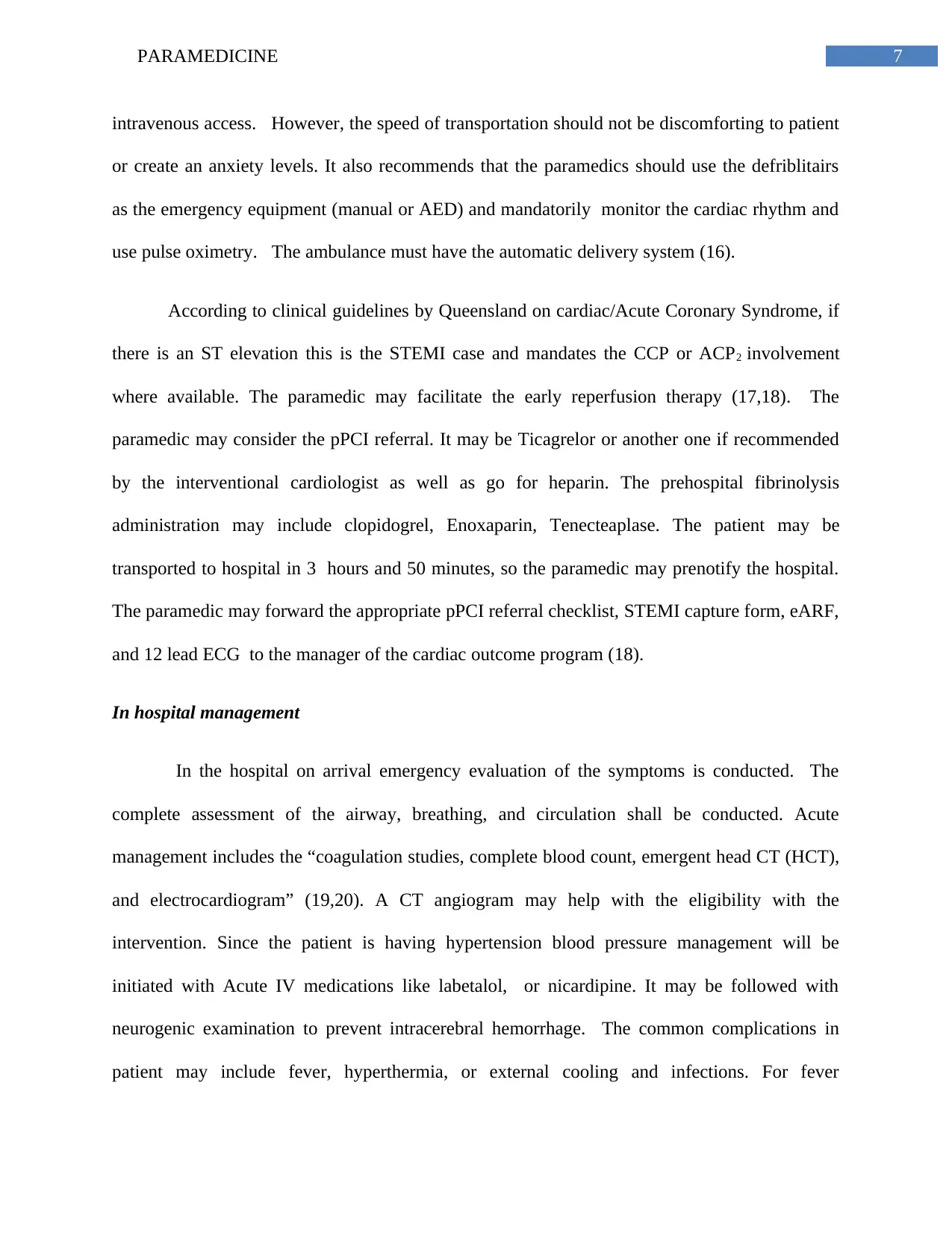
7PARAMEDICINE
intravenous access. However, the speed of transportation should not be discomforting to patient
or create an anxiety levels. It also recommends that the paramedics should use the defriblitairs
as the emergency equipment (manual or AED) and mandatorily monitor the cardiac rhythm and
use pulse oximetry. The ambulance must have the automatic delivery system (16).
According to clinical guidelines by Queensland on cardiac/Acute Coronary Syndrome, if
there is an ST elevation this is the STEMI case and mandates the CCP or ACP2 involvement
where available. The paramedic may facilitate the early reperfusion therapy (17,18). The
paramedic may consider the pPCI referral. It may be Ticagrelor or another one if recommended
by the interventional cardiologist as well as go for heparin. The prehospital fibrinolysis
administration may include clopidogrel, Enoxaparin, Tenecteaplase. The patient may be
transported to hospital in 3 hours and 50 minutes, so the paramedic may prenotify the hospital.
The paramedic may forward the appropriate pPCI referral checklist, STEMI capture form, eARF,
and 12 lead ECG to the manager of the cardiac outcome program (18).
In hospital management
In the hospital on arrival emergency evaluation of the symptoms is conducted. The
complete assessment of the airway, breathing, and circulation shall be conducted. Acute
management includes the “coagulation studies, complete blood count, emergent head CT (HCT),
and electrocardiogram” (19,20). A CT angiogram may help with the eligibility with the
intervention. Since the patient is having hypertension blood pressure management will be
initiated with Acute IV medications like labetalol, or nicardipine. It may be followed with
neurogenic examination to prevent intracerebral hemorrhage. The common complications in
patient may include fever, hyperthermia, or external cooling and infections. For fever
intravenous access. However, the speed of transportation should not be discomforting to patient
or create an anxiety levels. It also recommends that the paramedics should use the defriblitairs
as the emergency equipment (manual or AED) and mandatorily monitor the cardiac rhythm and
use pulse oximetry. The ambulance must have the automatic delivery system (16).
According to clinical guidelines by Queensland on cardiac/Acute Coronary Syndrome, if
there is an ST elevation this is the STEMI case and mandates the CCP or ACP2 involvement
where available. The paramedic may facilitate the early reperfusion therapy (17,18). The
paramedic may consider the pPCI referral. It may be Ticagrelor or another one if recommended
by the interventional cardiologist as well as go for heparin. The prehospital fibrinolysis
administration may include clopidogrel, Enoxaparin, Tenecteaplase. The patient may be
transported to hospital in 3 hours and 50 minutes, so the paramedic may prenotify the hospital.
The paramedic may forward the appropriate pPCI referral checklist, STEMI capture form, eARF,
and 12 lead ECG to the manager of the cardiac outcome program (18).
In hospital management
In the hospital on arrival emergency evaluation of the symptoms is conducted. The
complete assessment of the airway, breathing, and circulation shall be conducted. Acute
management includes the “coagulation studies, complete blood count, emergent head CT (HCT),
and electrocardiogram” (19,20). A CT angiogram may help with the eligibility with the
intervention. Since the patient is having hypertension blood pressure management will be
initiated with Acute IV medications like labetalol, or nicardipine. It may be followed with
neurogenic examination to prevent intracerebral hemorrhage. The common complications in
patient may include fever, hyperthermia, or external cooling and infections. For fever
Paraphrase This Document
Need a fresh take? Get an instant paraphrase of this document with our AI Paraphraser
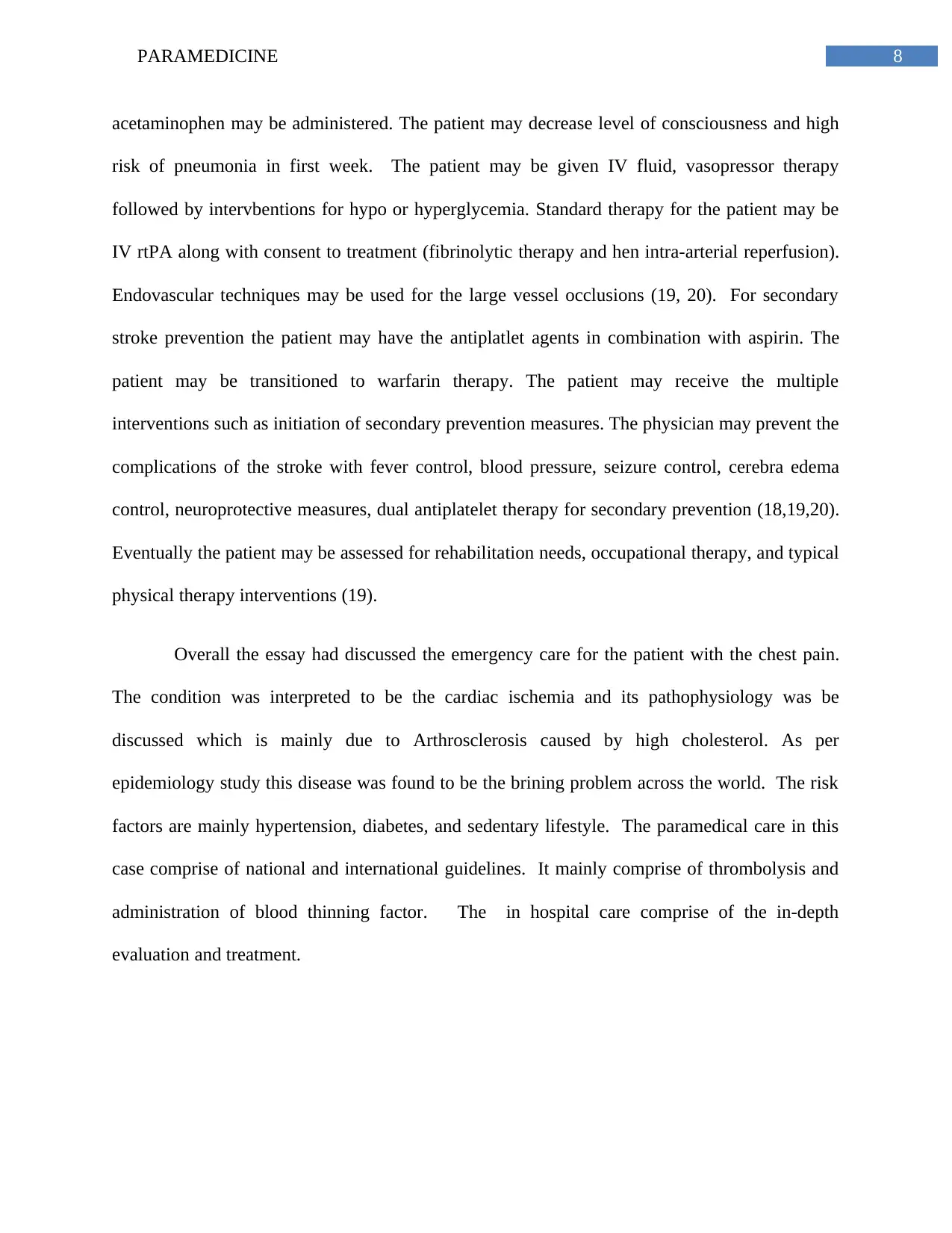
8PARAMEDICINE
acetaminophen may be administered. The patient may decrease level of consciousness and high
risk of pneumonia in first week. The patient may be given IV fluid, vasopressor therapy
followed by intervbentions for hypo or hyperglycemia. Standard therapy for the patient may be
IV rtPA along with consent to treatment (fibrinolytic therapy and hen intra-arterial reperfusion).
Endovascular techniques may be used for the large vessel occlusions (19, 20). For secondary
stroke prevention the patient may have the antiplatlet agents in combination with aspirin. The
patient may be transitioned to warfarin therapy. The patient may receive the multiple
interventions such as initiation of secondary prevention measures. The physician may prevent the
complications of the stroke with fever control, blood pressure, seizure control, cerebra edema
control, neuroprotective measures, dual antiplatelet therapy for secondary prevention (18,19,20).
Eventually the patient may be assessed for rehabilitation needs, occupational therapy, and typical
physical therapy interventions (19).
Overall the essay had discussed the emergency care for the patient with the chest pain.
The condition was interpreted to be the cardiac ischemia and its pathophysiology was be
discussed which is mainly due to Arthrosclerosis caused by high cholesterol. As per
epidemiology study this disease was found to be the brining problem across the world. The risk
factors are mainly hypertension, diabetes, and sedentary lifestyle. The paramedical care in this
case comprise of national and international guidelines. It mainly comprise of thrombolysis and
administration of blood thinning factor. The in hospital care comprise of the in-depth
evaluation and treatment.
acetaminophen may be administered. The patient may decrease level of consciousness and high
risk of pneumonia in first week. The patient may be given IV fluid, vasopressor therapy
followed by intervbentions for hypo or hyperglycemia. Standard therapy for the patient may be
IV rtPA along with consent to treatment (fibrinolytic therapy and hen intra-arterial reperfusion).
Endovascular techniques may be used for the large vessel occlusions (19, 20). For secondary
stroke prevention the patient may have the antiplatlet agents in combination with aspirin. The
patient may be transitioned to warfarin therapy. The patient may receive the multiple
interventions such as initiation of secondary prevention measures. The physician may prevent the
complications of the stroke with fever control, blood pressure, seizure control, cerebra edema
control, neuroprotective measures, dual antiplatelet therapy for secondary prevention (18,19,20).
Eventually the patient may be assessed for rehabilitation needs, occupational therapy, and typical
physical therapy interventions (19).
Overall the essay had discussed the emergency care for the patient with the chest pain.
The condition was interpreted to be the cardiac ischemia and its pathophysiology was be
discussed which is mainly due to Arthrosclerosis caused by high cholesterol. As per
epidemiology study this disease was found to be the brining problem across the world. The risk
factors are mainly hypertension, diabetes, and sedentary lifestyle. The paramedical care in this
case comprise of national and international guidelines. It mainly comprise of thrombolysis and
administration of blood thinning factor. The in hospital care comprise of the in-depth
evaluation and treatment.
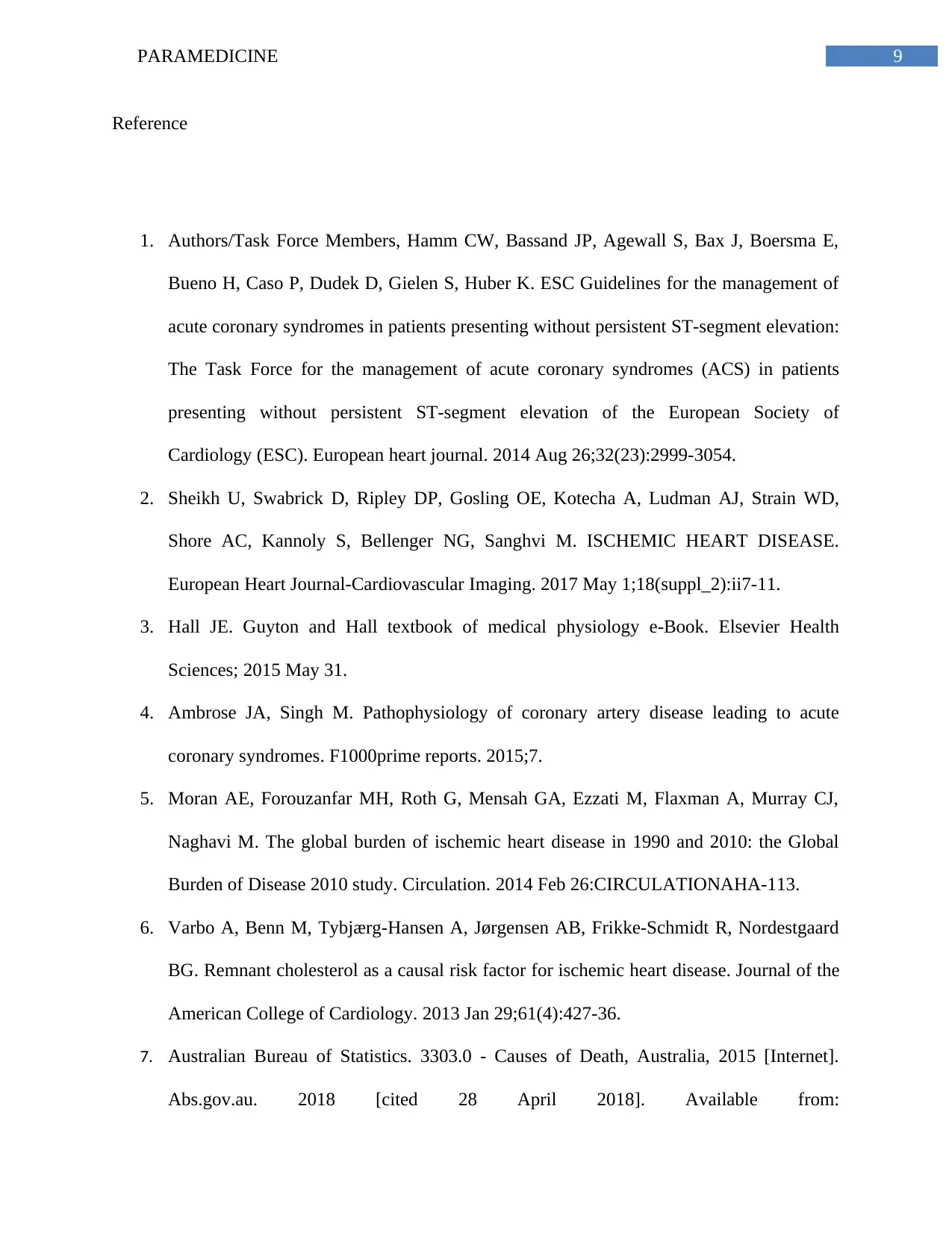
9PARAMEDICINE
Reference
1. Authors/Task Force Members, Hamm CW, Bassand JP, Agewall S, Bax J, Boersma E,
Bueno H, Caso P, Dudek D, Gielen S, Huber K. ESC Guidelines for the management of
acute coronary syndromes in patients presenting without persistent ST-segment elevation:
The Task Force for the management of acute coronary syndromes (ACS) in patients
presenting without persistent ST-segment elevation of the European Society of
Cardiology (ESC). European heart journal. 2014 Aug 26;32(23):2999-3054.
2. Sheikh U, Swabrick D, Ripley DP, Gosling OE, Kotecha A, Ludman AJ, Strain WD,
Shore AC, Kannoly S, Bellenger NG, Sanghvi M. ISCHEMIC HEART DISEASE.
European Heart Journal-Cardiovascular Imaging. 2017 May 1;18(suppl_2):ii7-11.
3. Hall JE. Guyton and Hall textbook of medical physiology e-Book. Elsevier Health
Sciences; 2015 May 31.
4. Ambrose JA, Singh M. Pathophysiology of coronary artery disease leading to acute
coronary syndromes. F1000prime reports. 2015;7.
5. Moran AE, Forouzanfar MH, Roth G, Mensah GA, Ezzati M, Flaxman A, Murray CJ,
Naghavi M. The global burden of ischemic heart disease in 1990 and 2010: the Global
Burden of Disease 2010 study. Circulation. 2014 Feb 26:CIRCULATIONAHA-113.
6. Varbo A, Benn M, Tybjærg-Hansen A, Jørgensen AB, Frikke-Schmidt R, Nordestgaard
BG. Remnant cholesterol as a causal risk factor for ischemic heart disease. Journal of the
American College of Cardiology. 2013 Jan 29;61(4):427-36.
7. Australian Bureau of Statistics. 3303.0 - Causes of Death, Australia, 2015 [Internet].
Abs.gov.au. 2018 [cited 28 April 2018]. Available from:
Reference
1. Authors/Task Force Members, Hamm CW, Bassand JP, Agewall S, Bax J, Boersma E,
Bueno H, Caso P, Dudek D, Gielen S, Huber K. ESC Guidelines for the management of
acute coronary syndromes in patients presenting without persistent ST-segment elevation:
The Task Force for the management of acute coronary syndromes (ACS) in patients
presenting without persistent ST-segment elevation of the European Society of
Cardiology (ESC). European heart journal. 2014 Aug 26;32(23):2999-3054.
2. Sheikh U, Swabrick D, Ripley DP, Gosling OE, Kotecha A, Ludman AJ, Strain WD,
Shore AC, Kannoly S, Bellenger NG, Sanghvi M. ISCHEMIC HEART DISEASE.
European Heart Journal-Cardiovascular Imaging. 2017 May 1;18(suppl_2):ii7-11.
3. Hall JE. Guyton and Hall textbook of medical physiology e-Book. Elsevier Health
Sciences; 2015 May 31.
4. Ambrose JA, Singh M. Pathophysiology of coronary artery disease leading to acute
coronary syndromes. F1000prime reports. 2015;7.
5. Moran AE, Forouzanfar MH, Roth G, Mensah GA, Ezzati M, Flaxman A, Murray CJ,
Naghavi M. The global burden of ischemic heart disease in 1990 and 2010: the Global
Burden of Disease 2010 study. Circulation. 2014 Feb 26:CIRCULATIONAHA-113.
6. Varbo A, Benn M, Tybjærg-Hansen A, Jørgensen AB, Frikke-Schmidt R, Nordestgaard
BG. Remnant cholesterol as a causal risk factor for ischemic heart disease. Journal of the
American College of Cardiology. 2013 Jan 29;61(4):427-36.
7. Australian Bureau of Statistics. 3303.0 - Causes of Death, Australia, 2015 [Internet].
Abs.gov.au. 2018 [cited 28 April 2018]. Available from:

10PARAMEDICINE
http://www.abs.gov.au/ausstats/abs@.nsf/Lookup/by%20Subject/3303.0~2015~Main
%20Features~Ischaemic%20Heart%20Disease~10001
8. Leon BM, Maddox TM. Diabetes and cardiovascular disease: Epidemiology, biological
mechanisms, treatment recommendations and future research. World journal of diabetes.
2015 Oct 10;6(13):1246.
9. Russo AM, Stainback RF, Bailey SR, Epstein AE, Heidenreich PA, Jessup M, Kapa S,
Kremers MS, Lindsay BD, Stevenson LW. Accf/hrs/aha/ase/hfsa/scai/scct/scmr 2013
appropriate use criteria for implantable cardioverter-defibrillators and cardiac
resynchronization therapy: A report of the american college of cardiology foundation
appropriate use criteria task force, heart rhythm society, american heart association,
american society of echocardiography, heart failure society of america, society for
cardiovascular angiography and interventions, society of cardiovascular computed
tomography, and society for cardiovascular .... Heart Rhythm. 2013 Apr 1;10(4):e11-58.
10. Gorgels AP. ST-elevation and non-ST-elevation acute coronary syndromes: should the
guidelines be changed?. Journal of electrocardiology. 2013 Jul 1;46(4):318-23.
11. Gupta A, Ghimire G, Hage FG. Guidelines in review: 2013 ACCF/AHA Guideline for
the Management of Heart Failure. Journal of Nuclear Cardiology. 2014 Apr 1;21(2):397-
9.
12. Sivaraman V, Yellon DM. Pharmacologic therapy that simulates conditioning for cardiac
ischemic/reperfusion injury. Journal of cardiovascular pharmacology and therapeutics.
2014 Jan;19(1):83-96.
13. Woo JS, Kim W, Ha SJ, Kim JB, Kim SJ, Kim WS, Seon HJ, Kim KS. Cardioprotective
Effects of Exenatide in Patients With ST-Segment–Elevation Myocardial Infarction
http://www.abs.gov.au/ausstats/abs@.nsf/Lookup/by%20Subject/3303.0~2015~Main
%20Features~Ischaemic%20Heart%20Disease~10001
8. Leon BM, Maddox TM. Diabetes and cardiovascular disease: Epidemiology, biological
mechanisms, treatment recommendations and future research. World journal of diabetes.
2015 Oct 10;6(13):1246.
9. Russo AM, Stainback RF, Bailey SR, Epstein AE, Heidenreich PA, Jessup M, Kapa S,
Kremers MS, Lindsay BD, Stevenson LW. Accf/hrs/aha/ase/hfsa/scai/scct/scmr 2013
appropriate use criteria for implantable cardioverter-defibrillators and cardiac
resynchronization therapy: A report of the american college of cardiology foundation
appropriate use criteria task force, heart rhythm society, american heart association,
american society of echocardiography, heart failure society of america, society for
cardiovascular angiography and interventions, society of cardiovascular computed
tomography, and society for cardiovascular .... Heart Rhythm. 2013 Apr 1;10(4):e11-58.
10. Gorgels AP. ST-elevation and non-ST-elevation acute coronary syndromes: should the
guidelines be changed?. Journal of electrocardiology. 2013 Jul 1;46(4):318-23.
11. Gupta A, Ghimire G, Hage FG. Guidelines in review: 2013 ACCF/AHA Guideline for
the Management of Heart Failure. Journal of Nuclear Cardiology. 2014 Apr 1;21(2):397-
9.
12. Sivaraman V, Yellon DM. Pharmacologic therapy that simulates conditioning for cardiac
ischemic/reperfusion injury. Journal of cardiovascular pharmacology and therapeutics.
2014 Jan;19(1):83-96.
13. Woo JS, Kim W, Ha SJ, Kim JB, Kim SJ, Kim WS, Seon HJ, Kim KS. Cardioprotective
Effects of Exenatide in Patients With ST-Segment–Elevation Myocardial Infarction
Secure Best Marks with AI Grader
Need help grading? Try our AI Grader for instant feedback on your assignments.
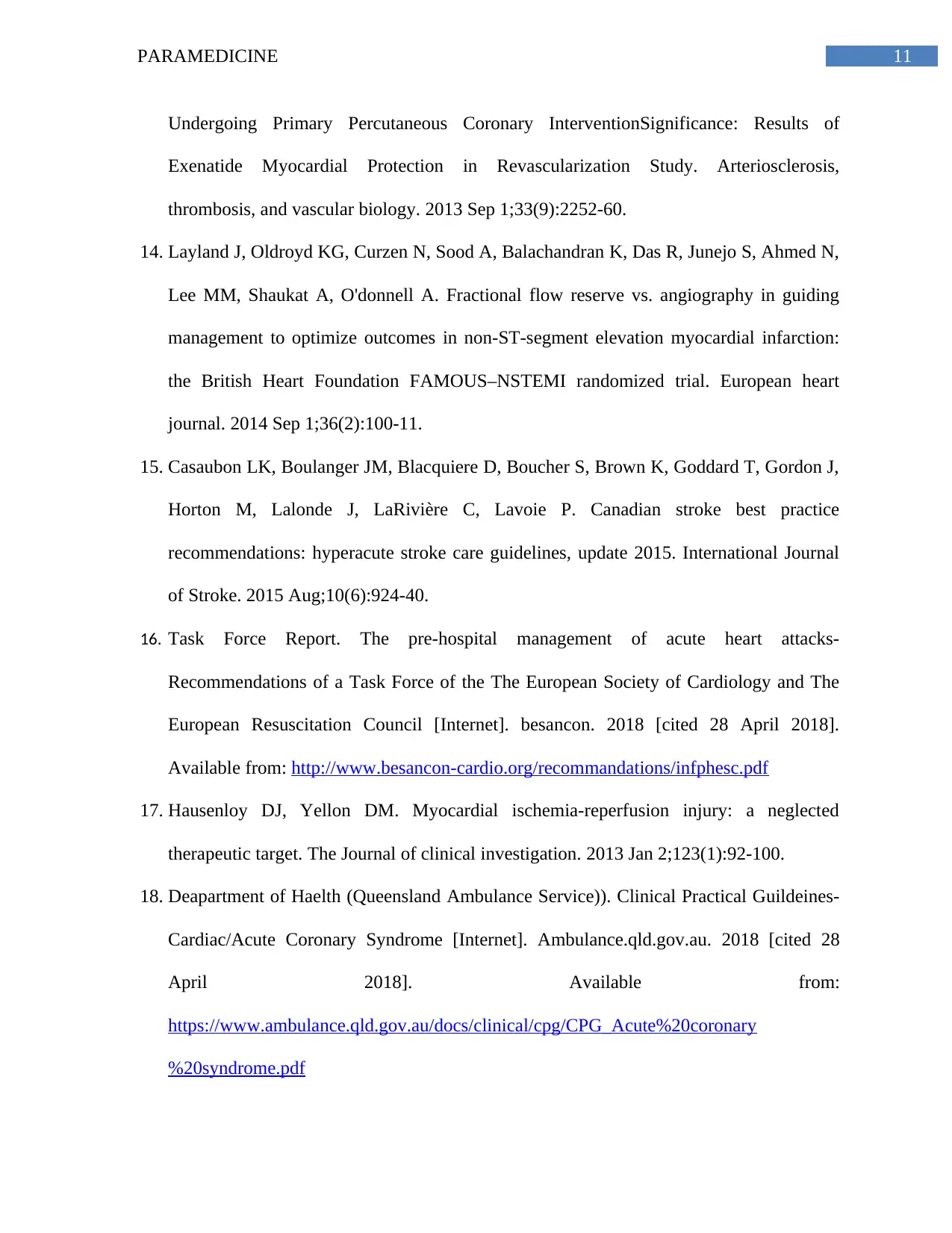
11PARAMEDICINE
Undergoing Primary Percutaneous Coronary InterventionSignificance: Results of
Exenatide Myocardial Protection in Revascularization Study. Arteriosclerosis,
thrombosis, and vascular biology. 2013 Sep 1;33(9):2252-60.
14. Layland J, Oldroyd KG, Curzen N, Sood A, Balachandran K, Das R, Junejo S, Ahmed N,
Lee MM, Shaukat A, O'donnell A. Fractional flow reserve vs. angiography in guiding
management to optimize outcomes in non-ST-segment elevation myocardial infarction:
the British Heart Foundation FAMOUS–NSTEMI randomized trial. European heart
journal. 2014 Sep 1;36(2):100-11.
15. Casaubon LK, Boulanger JM, Blacquiere D, Boucher S, Brown K, Goddard T, Gordon J,
Horton M, Lalonde J, LaRivière C, Lavoie P. Canadian stroke best practice
recommendations: hyperacute stroke care guidelines, update 2015. International Journal
of Stroke. 2015 Aug;10(6):924-40.
16. Task Force Report. The pre-hospital management of acute heart attacks-
Recommendations of a Task Force of the The European Society of Cardiology and The
European Resuscitation Council [Internet]. besancon. 2018 [cited 28 April 2018].
Available from: http://www.besancon-cardio.org/recommandations/infphesc.pdf
17. Hausenloy DJ, Yellon DM. Myocardial ischemia-reperfusion injury: a neglected
therapeutic target. The Journal of clinical investigation. 2013 Jan 2;123(1):92-100.
18. Deapartment of Haelth (Queensland Ambulance Service)). Clinical Practical Guildeines-
Cardiac/Acute Coronary Syndrome [Internet]. Ambulance.qld.gov.au. 2018 [cited 28
April 2018]. Available from:
https://www.ambulance.qld.gov.au/docs/clinical/cpg/CPG_Acute%20coronary
%20syndrome.pdf
Undergoing Primary Percutaneous Coronary InterventionSignificance: Results of
Exenatide Myocardial Protection in Revascularization Study. Arteriosclerosis,
thrombosis, and vascular biology. 2013 Sep 1;33(9):2252-60.
14. Layland J, Oldroyd KG, Curzen N, Sood A, Balachandran K, Das R, Junejo S, Ahmed N,
Lee MM, Shaukat A, O'donnell A. Fractional flow reserve vs. angiography in guiding
management to optimize outcomes in non-ST-segment elevation myocardial infarction:
the British Heart Foundation FAMOUS–NSTEMI randomized trial. European heart
journal. 2014 Sep 1;36(2):100-11.
15. Casaubon LK, Boulanger JM, Blacquiere D, Boucher S, Brown K, Goddard T, Gordon J,
Horton M, Lalonde J, LaRivière C, Lavoie P. Canadian stroke best practice
recommendations: hyperacute stroke care guidelines, update 2015. International Journal
of Stroke. 2015 Aug;10(6):924-40.
16. Task Force Report. The pre-hospital management of acute heart attacks-
Recommendations of a Task Force of the The European Society of Cardiology and The
European Resuscitation Council [Internet]. besancon. 2018 [cited 28 April 2018].
Available from: http://www.besancon-cardio.org/recommandations/infphesc.pdf
17. Hausenloy DJ, Yellon DM. Myocardial ischemia-reperfusion injury: a neglected
therapeutic target. The Journal of clinical investigation. 2013 Jan 2;123(1):92-100.
18. Deapartment of Haelth (Queensland Ambulance Service)). Clinical Practical Guildeines-
Cardiac/Acute Coronary Syndrome [Internet]. Ambulance.qld.gov.au. 2018 [cited 28
April 2018]. Available from:
https://www.ambulance.qld.gov.au/docs/clinical/cpg/CPG_Acute%20coronary
%20syndrome.pdf
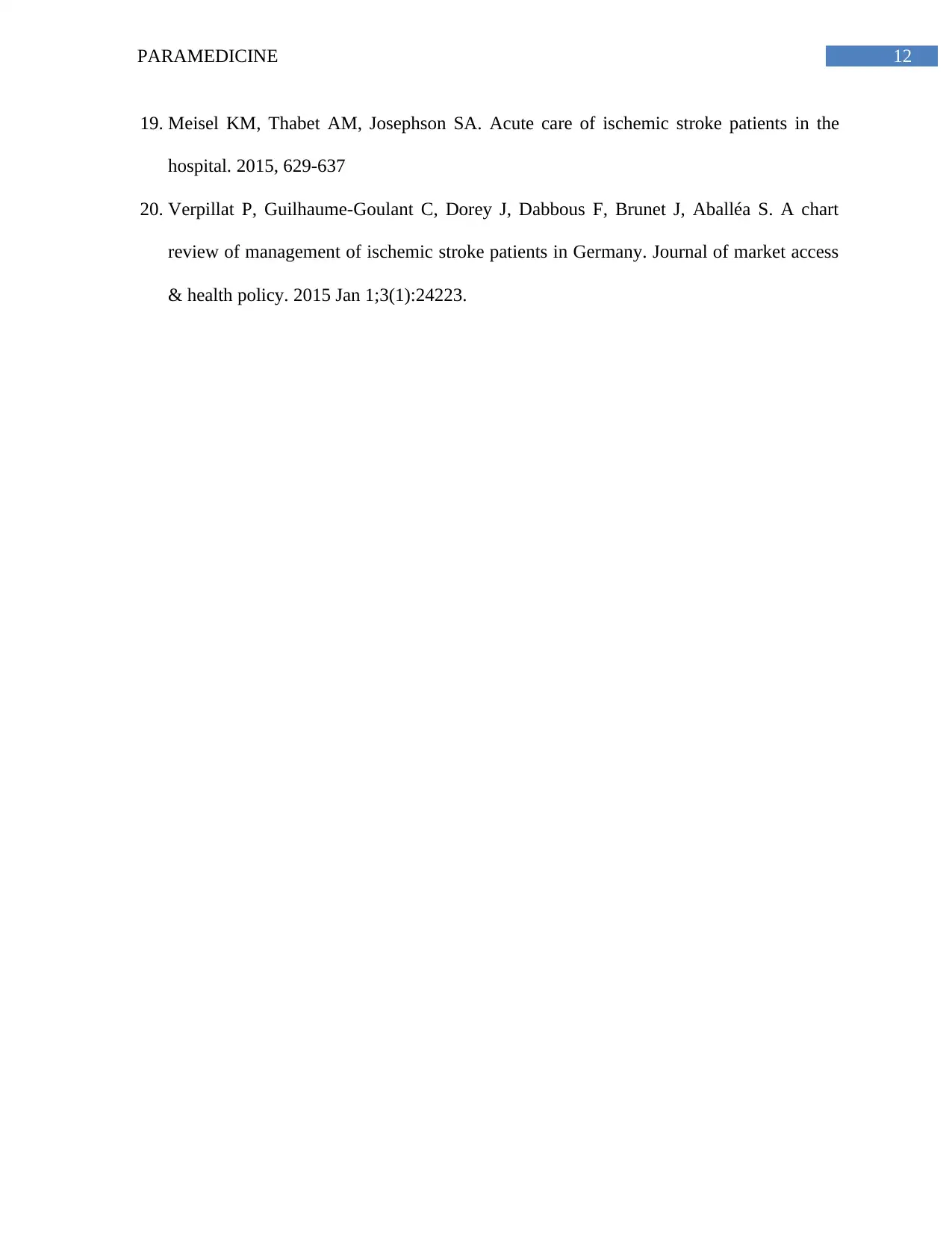
12PARAMEDICINE
19. Meisel KM, Thabet AM, Josephson SA. Acute care of ischemic stroke patients in the
hospital. 2015, 629-637
20. Verpillat P, Guilhaume-Goulant C, Dorey J, Dabbous F, Brunet J, Aballéa S. A chart
review of management of ischemic stroke patients in Germany. Journal of market access
& health policy. 2015 Jan 1;3(1):24223.
19. Meisel KM, Thabet AM, Josephson SA. Acute care of ischemic stroke patients in the
hospital. 2015, 629-637
20. Verpillat P, Guilhaume-Goulant C, Dorey J, Dabbous F, Brunet J, Aballéa S. A chart
review of management of ischemic stroke patients in Germany. Journal of market access
& health policy. 2015 Jan 1;3(1):24223.
1 out of 12
Related Documents
Your All-in-One AI-Powered Toolkit for Academic Success.
+13062052269
info@desklib.com
Available 24*7 on WhatsApp / Email
![[object Object]](/_next/static/media/star-bottom.7253800d.svg)
Unlock your academic potential
© 2024 | Zucol Services PVT LTD | All rights reserved.





